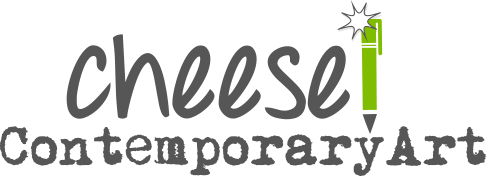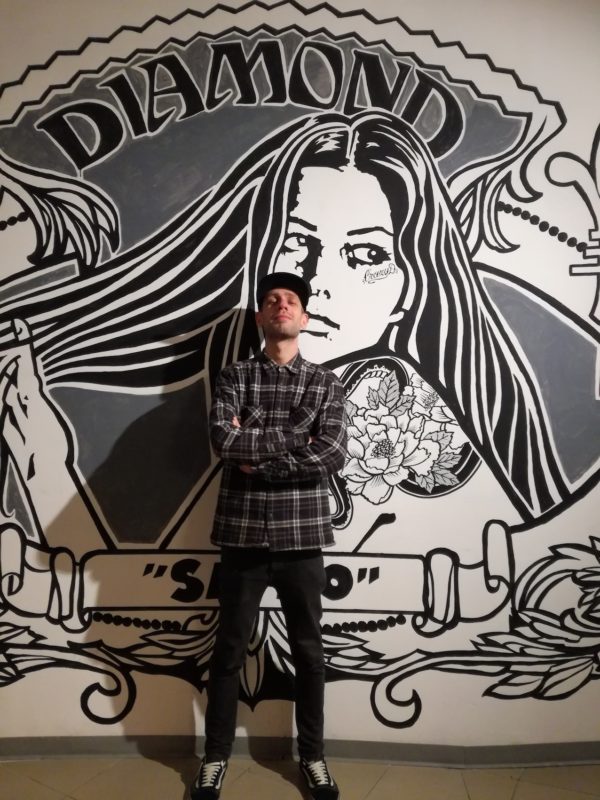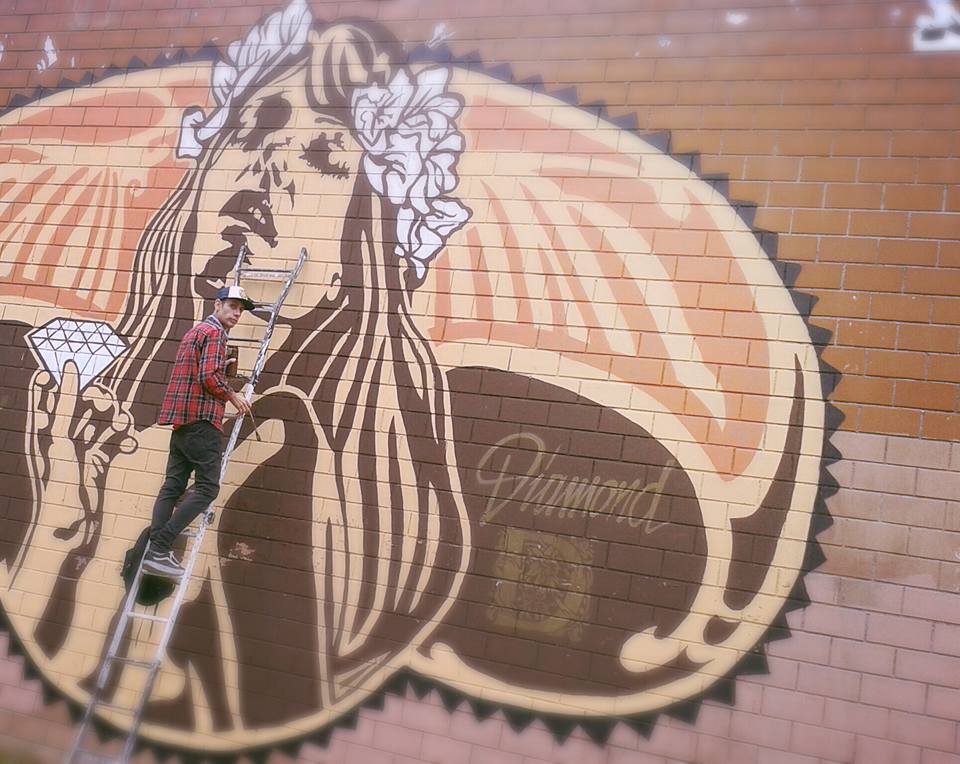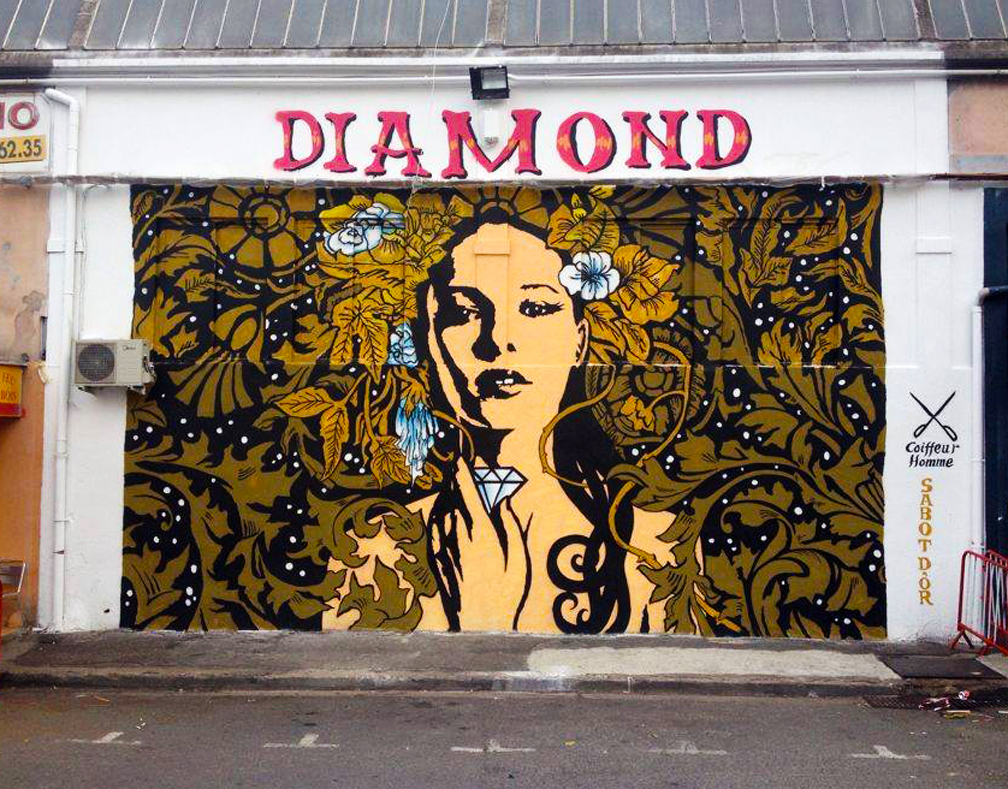Scroll down for English!
È facile imbattersi nella street art di Diamond per Roma. Vagando nella memoria.
A Roma sud ci sono un paio di poli densi dalla palazzina del Trullo a quella di Tormarancia nel complesso di Big City Life (in mezzo ai lavori di altri 22 colleghi), con fulcro a Ostiense tra la stazione della metro B San Paolo e l’ex Mattatoio di Testaccio, che sfoggia bucrani a due passi dagli ufficiali MACRO e La Pelanda. Ricordo gli stencil in giro per San Lorenzo una decina d’anni fa o più – ce ne sarà ancora qualcuna di silhouette sbiadita, un poster strappato sotto coltri di pubblicità abusiva.
In centro ricordo uno studio collettivo dietro Piazza Navona, sotto Lungotevere Tor di Nona, pieno di bombolette spray all’ingresso e appena fuori le prove su muro dell’allora crew TTS (i.e. The True Style). Poi i lavori a penna BIC su carta, non molto tempo fa in mostra alla Galleria Varsi, tra il Ghetto e Campo de’ fiori. C’era un tram, il 19, che sguisciava per zone centrali con fare serpentesco, imbrattato legalmente sotto supervisione curatoriale – prima e altrove sarebbero scattate le denunce.
Da giovincello si spostava di muro in muro tra spazi occupati e centri sociali, forse anche tra depositi di autobus o treni (non oso chiederglielo). Di sotterranei si parla ma per altra presentazione ufficiale, alla Casa dell’Architettura, anno 2012, con la Chinese Room.
>> Ecco dunque: Cina&Giappone fanno da colonne visibili/invisibili ai lavori di Diamond, l’architrave delle struttura è Nouveau, per una facciata che pare maledetta ma col sorriso. Sorrisi di pin up, orientali, e donnine degli inizi del secolo scorso, random. Immancabili tigri e serpenti. Su cosa ti stai concentrando in questo momento?
In questo periodo ho appena concluso due lavori, svolti con estremo piacere. Riguardano due mondi diversi: uno il mondo della musica (la copertina per il nuovo album di un rapper romano), e l’altro il mondo del vino (packaging design per una azienda vinicola).
>> Acid gothic e omaggio al Liberty. Ci sono i simbolisti di mezzo a rimandi a Klimt, Schiele e Mucha. Eclettico e inquieto, caleidoscopico e sfaccettato come il suo nome. Tutti fili che si uniscono in un’immagine pura, netta, in un’eleganza del lettering elaborato da monaco amanuense. Un paio di esempi. Un codice o un font che ti ha colpito (sei mai stato alla Biblioteca Angelica, quella secentesca, del convento agostiniano tra Piazza Navona e il Pantheon? o a un’altra?).
Sono infiniti i font che amo ed utilizzo, uno dei più apprezzati è di sicuro l’art nouveau caps. Purtroppo no, non sono mai stato all’Angelica, ma ho avuto il piacere di visitare la Biblioteca Vallicelliana, che comprende 130.000 volumi a stampa e 3000 manoscritti.
>> Come grandi vetrate Liberty. Il segno spesso e nitido che sagoma i suoi muri mi porta alla mente il contorno dei vetri piombati in stile Tiffany (il figlio creativo del più famoso Tiffany Senior, il gioielliere). Ci sono lavori di Diamond che, leggendoli in questo senso, invece che rimanere in superficie alleggeriscono l’edificio come se la parete si aprisse all’interno opalescente. Seppure totally flat, i suoi lavori su muro hanno una profondità esplosiva. Cosa diventa per te un edificio quando hai completato il tuo muro? E’ un semplice supporto o ti interessa particolarmente il luogo scelto o dove sei invitato a lavorare, e la gente che ci vive intorno/dentro?
Il “supporto”, il “muro”, la “facciata”, una volta completato il mio disegno prendono totalmente vita e incominciano a dialogare con il paesaggio e la popolazione circostante. Le persone che vivono intorno/dentro come sempre non vedono la cosa di buon occhio all’inizio. Ma più il disegno si va definendo, più lo stupore, la fiducia e l’ammirazione crescono nei loro occhi.
Diamond – Where to find his works in Rome – Street Art
Ambling through memories.
When wandering in Rome it is easy to encounter different murals signed by Diamond, especially in the southern part of the city namely on the outskirts of the neighborhood’s of il Trullo and Tormarancia. In the latter, within the structure known as Big City Life, one can find Diamond’s 145 sq. meters girl depicted amid the works of 22 other street artists.
The median point between these two neighborhoods may be considered the district of Ostiense, between the San Paolo metro station and Testaccio’s ex mattatoio, the city’s former slaughterhouse, on the outer walls of which Diamond flaunts a garland of bucrania (i.e. ox skulls); all this lies just a few steps away from the recognized museums of La Pelanda and MACRO (Museo d’Arte Contemporanea Roma).
I remember wandering around the San Lorenzo district near the University campus of La Sapienza, ten or so years ago, and seeing stencils by Diamond. They may still be there, faded outlines of stripped posters beneath layers of unauthorized advertisement. I recall Diamond’s atelier right in the city center, behind Piazza Navona and near Lungotevere Tor di Nona, that runs parallel to the Tiber river, the entrance gate carpeted with spray cans, the rear and front wall used as a sketch book full of details and colors. A great location, shared with other two members of his crew that was known at the time as TTS, The True Style.
I still reminisce Diamond’s drawings from a few years back made with pen on paper, not simple sketches but works in their own right, some of them recently shown in an exhibition at the Galleria Varsi held in the area of the former Jewish Ghetto and the market square of Campo de’Fiori. At the time a tramline, the 19, used to wind through the city center like a snake, its sides lawfully smeared with Diamond’s work – which in a different time might have incurred a damnatio memoriae.
Years ago, Diamond used to move from one wall to another, changing the areas dedicated to street art, working in (more or less) legal community centers and illegal squats, from bus depots to rail yards (I don’t even dare ask him about it). In 2012 he was officially invited by the Casa dell’Architettura to paint a Chinese Room in the large basement of the building housing the Italian’s Architects Association, not far from Termini train station.
Q >> China and Japan are visible / invisible pillars of your works, holding a structure that is fully Nouveau, with a cursed smiling façade. Moreover: cover-girls and pin-up’s smiles, like fashion models from the early 19th century.. Guaranteed: tigers and serpents. At the moment, what are you concentrating on?
A >> I have recently finished a number of works that I was truly delighted to create. They deal with two worlds that are very far apart from one another. The first one, music, is an album sleeve for an Italian rapper from Rome. For the second instead I worked on the packaging design of a winery.
Q >> Your work can range from Acid Gothic to Liberty style, recalling Symbolism in art, with cross references to Klimt, Schiele and Mucha. (Diamond is restless, multifaceted and kaleidoscopic as his name suggests). All the vibrant connections that influence your art are connected by a well defined image, that is clear, sharp, and undoubtedly marked by a great care for lettering – this last elaborated as if it were made by a monastic scribe. Is there any particular font that you really like? Have you ever visited any historical library in Rome, for example the Biblioteca Angelica close to the Pantheon?
A >> There is an unlimited source of fonts I like and can use. I would say one of my favorites is the “art nouveau caps”. Unfortunately I have never visited this library, but I had the chance to see the Biblioteca Vallicelliana. It has more than 130,000 printed volumes, and 3,000 manuscripts.
Q >> As if it were a great stained glass window, the thick and immaculate hand that outlines your murals reminds me of the contour of leaded glass in the Tiffany style (Louis Comfort Tiffany was the creative son of the better known Charles Lewis, i.e. Tiffany Senior the jeweler). Your building murals seem to open inwards the outer wall surface, lighting up the building with an opalescent surface. Even if two-dimensional, your works have an explosive sense of depth. How do you feel after completing a mural on a residential building? Is the wall a mere medium or do you take into account the place you choose, where you are invited to work and the people living there?
A >> The medium, the wall, the façade – once I finish my project – they come alive and start talking with their surroundings, with the people of that specific place. In the beginning it always happens that the work, when still a sketch, is not liked in the context of an urban area. But the more the drawing takes shape, the more I start seeing the wonder, confidence and respect in the eyes of those living in the area.









